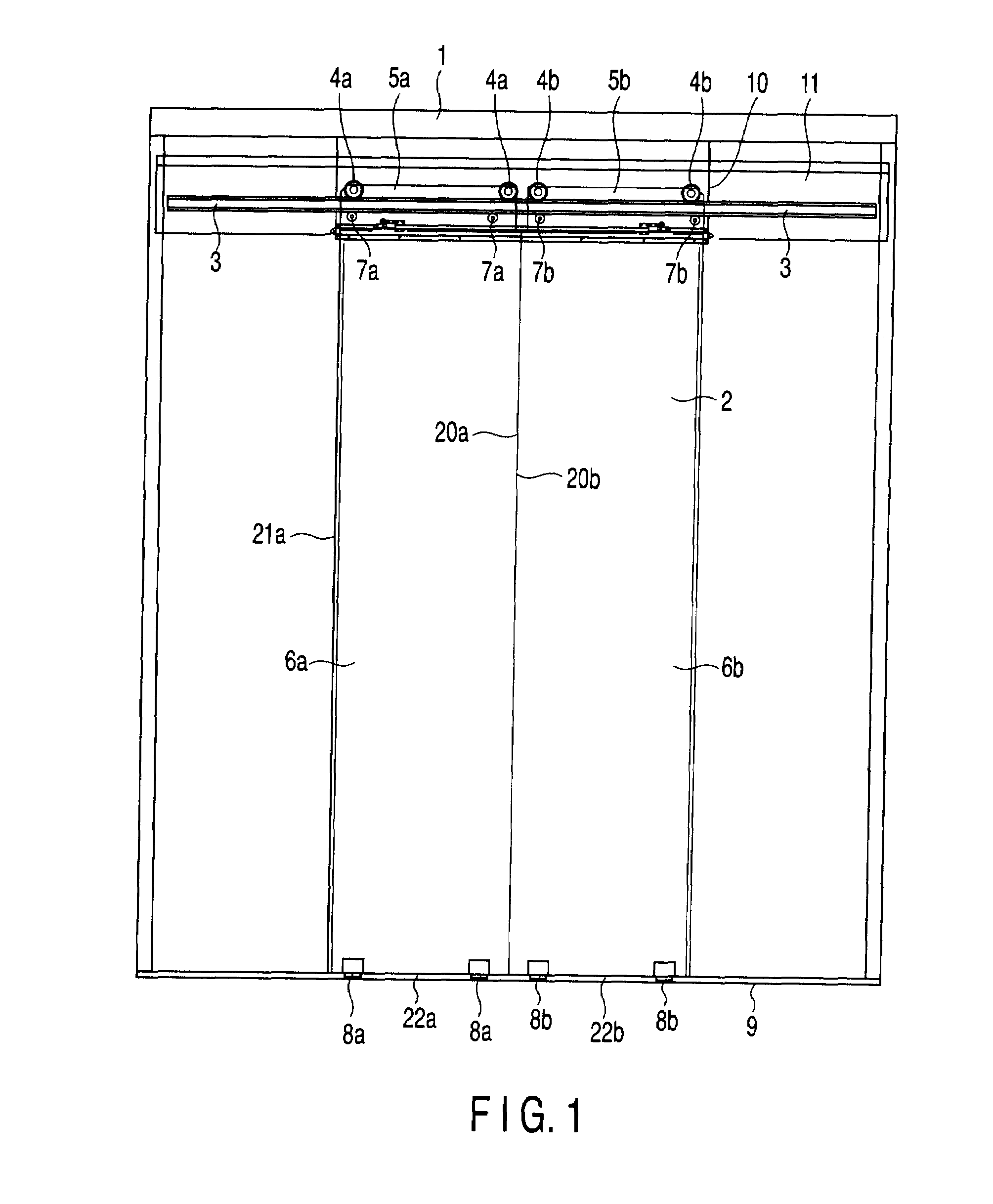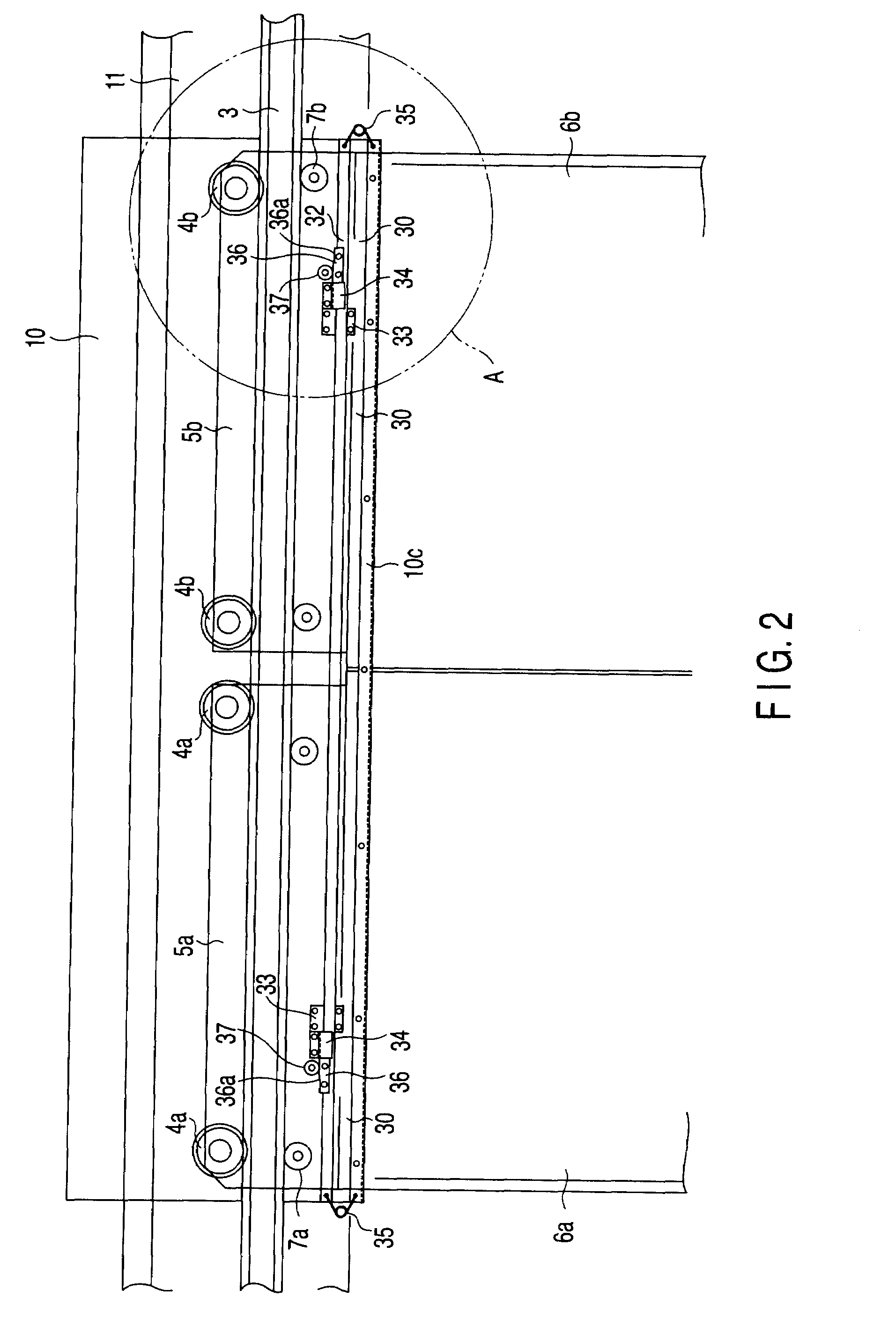Sealing device for elevator
a sealing device and elevator technology, applied in the direction of door/window accessories, transportation and packaging, door/window fittings, etc., can solve the problems of deteriorating the appearance of the elevator, exposing the residents to danger, and increasing the production cost, so as to achieve easy adjustment, small installation space, and high durability.
- Summary
- Abstract
- Description
- Claims
- Application Information
AI Technical Summary
Benefits of technology
Problems solved by technology
Method used
Image
Examples
first embodiment
[0042]the present invention will now be described with reference to FIGS. 1 to 10. As shown in FIG. 1, a gate of an elevator comprises a frame body 1 serving as a doorway member to surround an opening portion 2 of an elevator shaft wall. A hanger rail 3 is installed in an upper section of the frame body 1 in a horizontal direction.
[0043]A pair of hall doors 6a and 6b are suspended from the hanger rail 3 by means of hanger rollers 4a and 4b and hangers 5a and 5b. The hall doors 6a and 6b move symmetrically to left and right along the hanger rail 3.
[0044]In order to prevent the hanger rollers 4a and 4b from coming off the rail, lower side support rollers 7a and 7b are arranged on the lower side of the hanger rail 3, and they are rotatably mounted on the hangers 5a and 5b, respectively.
[0045]The lower portions of the hall doors 6a and 6b are guided along a doorsill 9 provided to be substantially flush with the floor of the hall, by means of guide shoes 8a and 8b. Of the surrounding por...
second embodiment
[0060]the present invention will now be described in connection with a case where the present invention is applied to a door device of the one side sliding type with reference to FIGS. 8 to 12. FIG. 8 is a perspective front view of upper sections of hall doors 6c and 6d of the one side sliding type, viewed from the shaft side. FIGS. 9 to 12 are cross sectional views illustrating the structure of the door device with the respective parts. From FIGS. 9 to 12, the hall side is located on the right-hand side of the figure and the shaft side is located on the left-hand side of the figure.
[0061]As shown in FIG. 8, the low-speed hall door 6c and the high-speed hall door 6d are arranged to be displaced from each other in front and rear positions. FIG. 8 shows a state in which the hall doors 6c and 6d are closed. While opening the hall doors 6c and 6d from this state, the low-speed hall door 6c moves at a low speed towards a door case 50 on the left-hand side of the figure, and the high-spee...
third embodiment
[0083]the present invention will now be described with reference to FIGS. 13 and 14. FIG. 13 is a cross sectional view illustrating the upper section of the hall door 6e while it is not completely closed, and FIG. 14 is a cross sectional view illustrating the upper section of the hall door 6e when it is completely closed.
[0084]A belt-like fluorine-based rubber sheet 60 is provided horizontally on the folded portion 14c of the door header 14 to extend along the longitudinal direction of the folded portion 14c. The lower end portion of the rubber sheet 60 is pinched between the lower holder plate 61 and the folded portion 14c to be fixed to the folded portion 14c. The upper end portion of the rubber sheet 60 is extended above the folded portion 14c to face the upper section of the hall door 6e.
[0085]The back support plate 33 and front support plate 34, each formed of a synthetic resin, are attached to the inner surface of the lower end portion of the header case 11. A holder plate 62...
PUM
 Login to View More
Login to View More Abstract
Description
Claims
Application Information
 Login to View More
Login to View More - R&D
- Intellectual Property
- Life Sciences
- Materials
- Tech Scout
- Unparalleled Data Quality
- Higher Quality Content
- 60% Fewer Hallucinations
Browse by: Latest US Patents, China's latest patents, Technical Efficacy Thesaurus, Application Domain, Technology Topic, Popular Technical Reports.
© 2025 PatSnap. All rights reserved.Legal|Privacy policy|Modern Slavery Act Transparency Statement|Sitemap|About US| Contact US: help@patsnap.com



